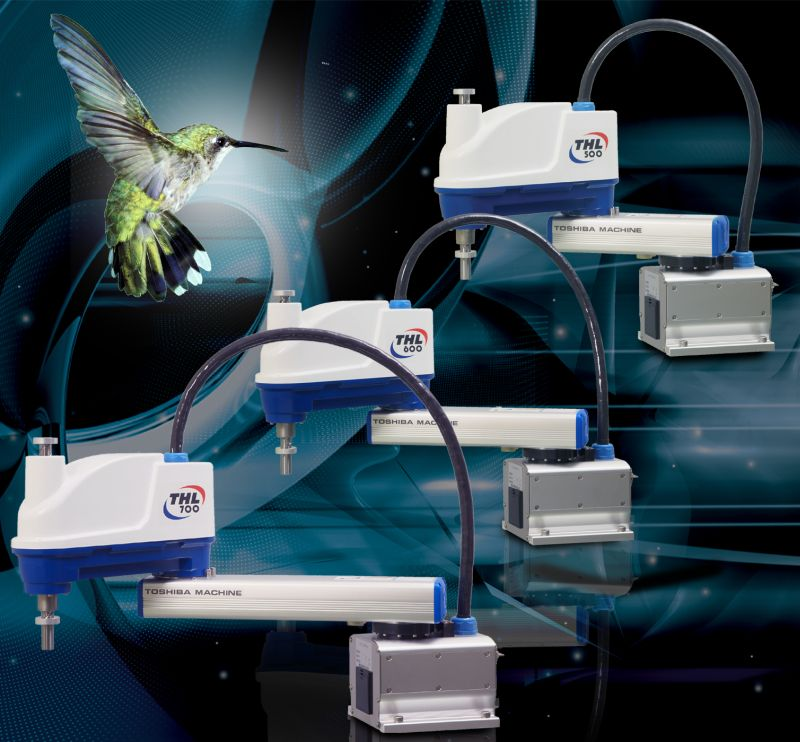 Since their launch last year, TM Robotics’ Toshiba Machine THL SCARA robots have been the hot sellers. Their popularity is no doubt due in part to their relatively low cost compared with similar performance specifications, but their low mass has been a benefit to system integrators and low energy consumption is a bonus for end users. They are ideal in stand alone applications, but their ease of integration holds great appeal to machine builders and integrators too.
Since their launch last year, TM Robotics’ Toshiba Machine THL SCARA robots have been the hot sellers. Their popularity is no doubt due in part to their relatively low cost compared with similar performance specifications, but their low mass has been a benefit to system integrators and low energy consumption is a bonus for end users. They are ideal in stand alone applications, but their ease of integration holds great appeal to machine builders and integrators too.
The Toshiba Machine THL models satisfy the growing demand for affordable, flexible automation in applications outside of industries such as packaging, materials handling and welding where robots have been installed for decades.
The aim was to achieve low mass and low inertia with the necessary rigidity from which high accuracy is attained. Reduction in mass is thanks to the use of lightweight cast aluminium mechanical components that have a series of ribbed sections to provide rigidity. As a result, smaller servo motors have been fitted. Moreover, because the lightweight system generates substantially less inertia a simplified gearbox has been used.
The THL range is up to 50% lighter than other Toshiba Machine models and the robots consume 50% less electricity. Performance compares favourably with other models and the new robots feature easier maintenance than previously.
Available on 300mm, 400mm, 500mm, 600mm, 700mm, 800mm, 900mm and 1000mm arm lengths, the next surprising revelation is that across all models there are just three price differentials: THL300 and 400 are one price; THL500, 600 and 700 are one price; and the THL800,900 and 1000 are one price. Toshiba Machine explains that since the only difference between the robots is the length of the extruded aluminium tube that forms the arm’s main beam, the cost difference is negligible across each of the three groups of robots.
Each robot has four axes of movement including ±360° rotational, with a working envelope of ±125° on the first axis and ±145° on axis two. Maximum composite speeds using axes one and two are impressive while cycle times, even with maximum payloads are breathtakingly fast. The allowable moment of inertia is just 0.2kg/m2 and thanks to the use of absolute encoders repeatability in X-Y is a mere 0.01mm.
Working in practice
One of the first Toshiba Machine THL range applications was in China. The growth of electronic manufacturing services (EMS) in China has been exponential as manufacturers seek to gain the best value possible from their production facilities.
An innovative robot cell has been developed for one such Chinese EMS that sees Toshiba Machine Scara robots deployed in an assembly operation centred on automated screwing of components together. The manufacturing cell is making body components for Smartphone’s.
EMS operations in China have been largely very labour intensive but there is a marked transition to automated production, due to increases in labour costs and increasing demand for higher quality, precision and efficiency.
The robot application uses a Toshiba Machine THL300 Scara robot to load the work pieces. The location of tapped holes in the work piece is identified by a vision system. The THL300 then fixes the screws using a programmable screwdriver unit. The secured screws are then inspected before the robot unloads the work pieces.
The work pieces are contained on a turntable with six fixtures/stages. A pneumatic actuator holds down the Smartphone chassis onto the frame. This frame does not have to be high-precision because the holes are aligned using the vision system, hence the fixturing is relatively inexpensive.
The vision system passes position data to the robot controller via DeviceNet.
The THL300 has a programmable screw driver unit handling the small M1 screws that are just 1mm in length. The screws are picked from a palette with each screw being held slanted, rather than straight. Specialised technology went into the design of the screwdriver unit.
For the inspection of the screws an X-Y stage is used with a probe to inspect the height of each screw. Position data from the vision system is also fed to the X-Y stage.
When the parts are unloaded a touch panel display shows “good” or “bad” so the operator can unload and sort while also performing a visual inspection.
The system is semi-automatic in that the operator loads, unloads, and moves the turntable to the next phase using switches. Screws are also loaded on the palette by manual labour.
Cycle time improvements and greater degree of automation are the next development challenges.
One invaluable feature of the system is that the inching distance of the SCARA can be changed by parameter settings. For example, the factory set inching value is in the 0.* mm scale. However, for this application it was able to be changed to 0.0* level to cater for programming such a small scale application.
TM Robotics
01707 290370


